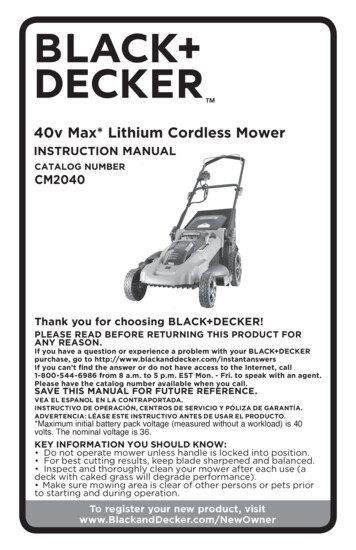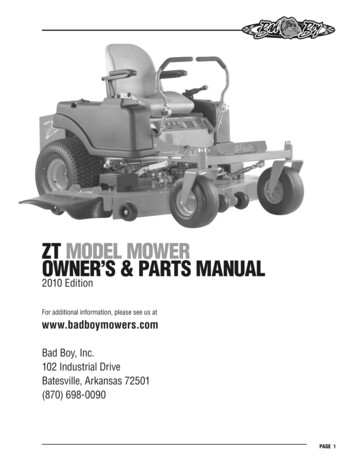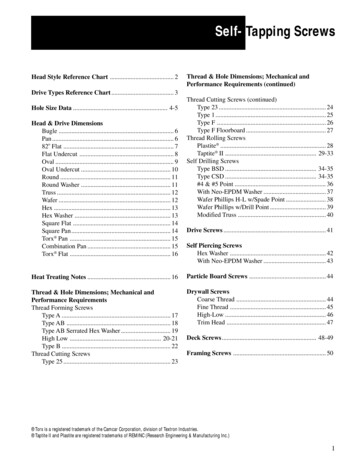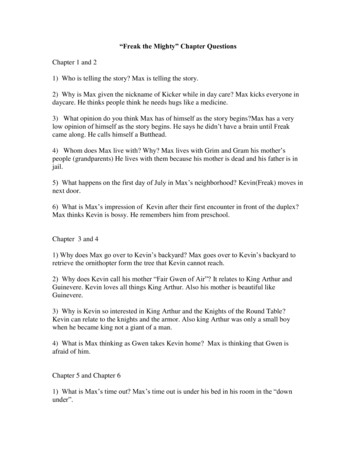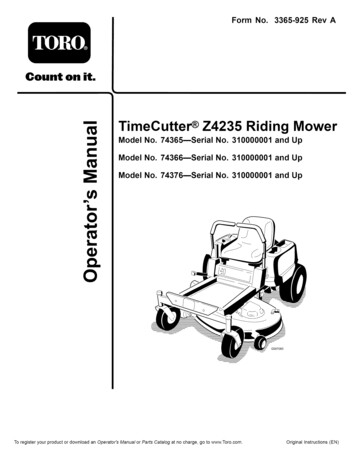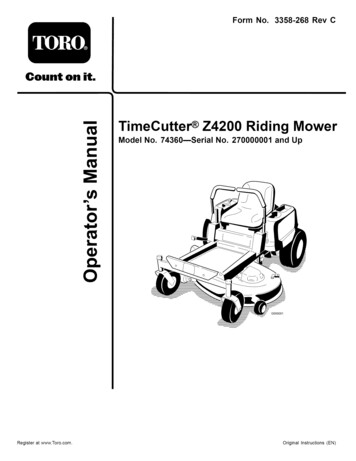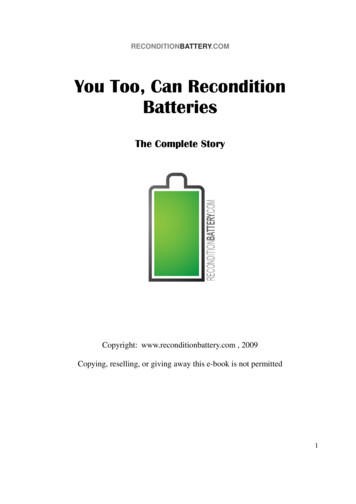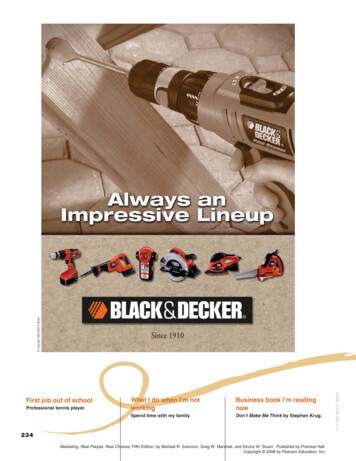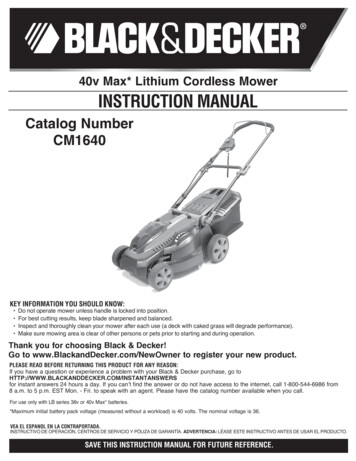
Transcription
40v Max* Lithium Cordless MowerINSTRUCTION MANUALCatalog NumberCM1640key information you should know: Do not operate mower unless handle is locked into position.For best cutting results, keep blade sharpened and balanced.Inspect and thoroughly clean your mower after each use (a deck with caked grass will degrade performance).Make sure mowing area is clear of other persons or pets prior to starting and during operation.Thank you for choosing Black & Decker!Go to www.BlackandDecker.com/NewOwner to register your new product.PLEASE READ Before returning this product for any reason:If you have a question or experience a problem with your Black & Decker purchase, go tohttp://www.blackanddecker.com/instantanswersfor instant answers 24 hours a day. If you can’t find the answer or do not have access to the internet, call 1-800-544-6986 from8 a.m. to 5 p.m. EST Mon. - Fri. to speak with an agent. Please have the catalog number available when you call.For use only with LB series 36v or 40v Max* batteries.*Maximum initial battery pack voltage (measured without a workload) is 40 volts. The nominal voltage is 36.VEA EL ESPANOL EN LA CONTRAPORTADA.INSTRUCTIVO DE OPERACIÓN, CENTROS DE SERVICIO Y PÓLIZA DE GARANTÍA. ADVERTENCIA: LÉASE ESTE INSTRUCTIVO ANTES DE USAR EL PRODUCTO.Save this Instruction Manual for Future reference.
SAFETY GUIDELINES - DEFINITIONSIt is important for you to read and understand this manual. The information it contains relates to protecting YOUR SAFETY and PREVENTINGPROBLEMS. The symbols below are used to help you recognize this information.DANGER: Indicates an imminently hazardous situation which, if not avoided, will result in death or serious injury.WARNING: Indicates a potentially hazardous situation which, if not avoided, could result in death or serious injury.CAUTION: Indicates a potentially haz ard ous situation which, if not avoided, may result in minor or mod er ate injury.NOTICE: Used without the safety alert symbol indicates potentially hazardous situation which, if not avoided, may result in property damage.The following are explanations of important safety hazardpictorials on the mower.1. User must read and understand the instruction manual.to ensure they are in good working order and will operate properlyand perform their intended function. Replace a damaged latch,guard or other safety device before further use.10. Never leave a running mower unattended.11. Always release the bail handle to stop the motor and wait until theblade comes to a complete stop and remove the safety key beforecleaning the mower, removing the grass catcher, un-clogging thedischarge guard, when leaving the mower, or before making anyadjustments, repairs or inspections.12. Operate mower only in daylight or good artificial light when objects in thepath of the blade are clearly visible from the operating area of the mower.13. Do not operate mower while under the influence of alcohol or drugs,or when you are tired or ill. Always stay alert, watch what you aredoing, and use common sense.14. Avoid dangerous environments. Never operate mower in damp orwet grass, never use mower in the rain. Always be sure of yourfooting; walk; never run.15. Disengage the drive system, if so equipped, before starting the motor.16. If the mower should start to vibrate abnormally, release the bailhandle, wait for the blade to stop and remove the safety key andbattery pack, then check for the cause immediately. Vibration isgenerally a warning of trouble.17. Always wear proper eye and respiratory protection when operatingthe mower.18. The use of any accessory or attachment not recommended foruse with this mower could be hazardous. Only use accessoriesapproved by Black & Decker.19. Never overreach while operating the mower. Always be sure to keepproper footing and balance at all times while operating the mower.2. To avoid the risk of serious injury do not mow up anddown slopes. Always mow across slopes.3. To avoid the risk of injury to bystanders keep all personsand pets at a safe distance from the mower while operating.4. Rotating blades can cause serious injury. Keep hands andfeet clear of mower deck and discharge opening at all times.Always be sure blade has stopped (wait for the blade to stoprotating (approximately 3 seconds) after releasing bail handleand removing the safety key) before removing and replacing grass catcher,cleaning, servicing, transporting or lifting the mower.5. Objects struck by mower blade can cause serious injury.Stay behind the handle when the motor is running. Alwaysensure persons and pets are clear of the discharge from themower while operating. Always inspect mowing area beforemowing and remove objectsthat could be thrown by blade. Release bail handle to turn moweroff and wait for the blade to stop rotating (approximately 3 seconds)before crossing walk, roads, patio and gravel drives.SLOPE OPERATIONWARNING: Important Safety Warnings andInstructionsWARNING: When using electric lawn mowers, basic safetySlopes are a major factor related to slip and fall accidents, which canresult in severe injury. Operation on all slopes requires extra caution. Ifyou feel uneasy on a slope, do not mow it.1. Mow across the face of slopes; never up and down. Exerciseextreme caution when changing direction on slopes.2. Watch for holes, ruts, bumps, rocks, or other hidden objects. Uneventerrain could cause a slip and fall accident. Tall grass can hide obstacles.3. Do not mow on wet grass or excessively steep slopes. Poor footingcould cause a slip and fall accident.4. Do not mow near drop-offs, ditches, or embankments. You couldlose your footing or balance.precautions should always be followed to reduce the risk of fire, electricshock, and personal injury, including the following:.READ ALL INSTRUCTIONSTo reduce risk of injury: Before any use, be sure everyone using this tool reads and understandsall safety instructions and other information contained in this manual. Save these instructions and review frequently prior to use and ininstructing others.CHILDRENDANGER: IMPORTANT SAFE PRACTICES FOR Tragic accidents can occur if the operator is not alert to the presence ofchildren. Children are often attracted to the mower and the mowingWALK-BEHIND MOWERSactivity. Never assume that children will remain where you last saw them.1. Keep children out of the mowing area and under the watchful careof a responsible adult other than the operator.2. Be alert and turn mower off if a child enters the area.3. Never allow children to operate the mower.4. Use extra care when approaching blind corners, shrubs, trees, orother objects that may block your view of a child.This mower is capable of amputating hands and feet and throwingobjects. Failure to observe the following safety instructions could resultin serious injury or death.GENERAL OPERATION1. Read, understand, and follow all instructions on the mower and inthe instruction manual before starting.2. Do not put hands or feet near or under the mower. Keep clear ofthe discharge opening at all times.3. Only allow responsible adults, who are familiar with the instructions,to operate this mower.4. Clear the area where the mower is to be used of objects such asrocks, sticks, wire, toys, bones, etc., which could be thrown bythe blade. Objects struck by the blade can cause severe injury topersons. Stay behind the handle when the motor is running.5. Be sure the area surrounding the mower is clear of bystanders beforeoperating. All bystanders and pets should be kept at a safe distance.Stop the mower if anyone enters the area surrounding the mower.6. Do not operate mower barefooted or while wearing sandals. Alwayswear substantial footwear.7. Do not pull mower backward unless absolutely necessary. Alwayslook down and behind before and while moving backward.8. Never direct discharged material toward anyone. Avoid dischargingmaterial against a wall or obstruction. Material may ricochet backtoward the operator. Release bail handle to turn mower off and stopthe blade when crossing gravel surfaces.9. Do not operate mower without the entire grass catcher, dischargeguard, rear guard, or other safety protective devices in place andworking. Periodically check all guards and safety protective devicesGENERAL SERVICE1. Never operate mower in a closed area.2. Keep all nuts and bolts tight to be sure the equipment is in safeworking condition.3. Never tamper with safety devices. Check their proper operation regularly.4. Keep mower free of grass, leaves, or other debris build-up. Allowmower to cool before storing.5. If you strike a foreign object, release bail handle to turn mower off,wait for the blade to stop and remove the safety key and batterypack, then inspect the mower. Repair, any damage, before startingand operating the mower.6. Never make any adjustments or repairs with the motor running orwhile the safety key is in the mower.7. Always remove safety key and battery pack before adjusting, cleaning,repairing, inspecting, transporting, storing or leaving the mower.8. Check grass catcher components and the discharge guard frequently andwhen necessary replace with Black & Decker recommended parts only.9. Mower blades are sharp. Wrap the blade or wear gloves, and useextra caution when servicing them.10. Maintain or replace safety and instruction labels, as necessary.2
Store Idle Lawn Mower Indoors – When not in use, lawn mower shouldbe stored in an indoor dry and locked-up place – out of reach of children. Maintain Lawn Mower With Care – Keep cutting edges sharp andclean for best and safest performance. Keep guards in place and in working order. Keep blades sharp. Keep hands and feet away from cutting area. Objects struck by the lawn mower blade can cause severe injuriesto persons. The lawn should always be carefully examined andcleared of all objects prior to each mowing. If lawn mower strikes a foreign object, follow these steps: Stop lawn mower. Release the bail handle. Remove battery and safety key. Inspect for damage. Repair any damage before restarting and operating the lawn mower. Use identical replacement blades onlyWARNING: Some dust created by this product contains chemicals known to the State of California to cause cancer, birth defects orother reproductive harm. Some examples of these chemicals are: compounds in fertilizers compounds in insecticides, herbicides and pesticides arsenic and chromium from chemically treated lumberTo reduce your exposure to these chemicals, wear approved safetyequipment such as dust masks that are specially designed to filter outmicroscopic particles.This device complies with Part 15 of the FCC Rules. Operation issubject to the following two conditions: (1) this device may not causeharmful interference, and (2) this device must accept any interferencereceived, including interference that may cause undesired operation.NOTE: This equipment has been tested and found to comply with thelimits for Class B digital device, pursuant to part 15 of the FCC Rules.These limits are designed to provide reasonable protection againstharmful interference in a residential installation. This equipmentgenerates, uses and can radiate radio frequency energy and, if notinstalled and used in accordance with the instructions, may causeharmful interference to radio communications. However, there is noguarantee that interference will not occur in a particular installation. Ifthis equipment does cause harmful interference to radio or televisionreception, which can be determined by turning the equipment off andon, the user is encouraged to try to correct the interference by one ormore of the following measures:. Reorient or relocate the receiving antenna. Increase the separation between the equipment and the receiver. Connect the equipment into an outlet on a circuit different from that towhich the receiver is connected. Consult the dealer or an experienced radio/TV technician for help.Changes or modifications to this unit not expressly approved by the partyresponsible for compliance could void the user’s authority to operate theequipment. This Class B digital apparatus complies with Canadian ICES-003.save these instructionsFUNCTIONAL DESCRIPTION (FIG. A)WARNING: GENERAL SAFETY WARNINGS ANDINSTRUCTIONS FOR ALL TOOLS1. Switch box2. Safety key3. Bail handle4. Upper-handle5. Lower-handle6. Upper-handle attachment levers7. Lower-handle attachment levers 8. Cut height adjust lever9. Grass collection bag10. Rear flap11. Battery port12. Carrying handle13. Stop/go indicator THIS TOOL CAN BE DANGEROUS. Follow all warnings and SafetyInstructions in this manual. The operator is responsible for followingwarnings and instructions in this manual and on unit. Restrict use ofthis mower to persons who read, understand and follow warnings andinstructions in this manual and on unit. Avoid Dangerous Environment – Don’t use lawn mowers in damp orwet locations. Don’t Use In Rain. Keep Children Away – All visitors should be kept a safe distance fromwork area. Dress Properly – Do not wear loose clothing or jewelry. They canbe caught in moving parts. Use of rubber gloves and footwear isrecommended when working outdoors. Use Safety Glasses – Always use face or dust mask if operation is dusty. Use Right Appliance – Do not use lawn mower for any job except thatfor which it is intended. Use of Extension CordsMake sure the extension cord is in good condition before using. Always usethe proper size extension cords with the tool – that is, proper wire size forvarious lengths of cord and heavy enough to carry the current the tool willdraw. Use of an undersized cord will cause a drop in line voltage resultingin loss of power and overheating. For proper size cords see chart below.Volts120V240VAmpereMoreThan0610 12 -A65101291178161414121412Not RecommendediMPORtANt SAFEtY iNStRuCtiONS FOR BAttERYChARGERS CHECK FOR DAMAGED PARTS. Before further use of the mower,a guard or other part that is damaged should be carefully checkedto determine that it will operate properly and perform its intendedfunction. Check for alignment of moving parts, binding of movingparts, breakage of parts, mounting, and any other conditions that mayaffect their operation. A guard or other part that is damaged should beproperly repaired or replaced by an authorized service center unlessotherwise indicated elsewhere in this manual. REPAIRS AND SERVICE. Repairs, maintenance and anyadjustments not specified in this manual should be performed byBlack & Decker authorized service centers or other qualified serviceorganizations, always using identical replacement parts.SAVE THESE INSTRUCTIONS: This manual contains important safetyinstructions for battery chargers. Before using charger, read all instructions and cautionary markings oncharger, battery pack, and product using battery pack.WARNING: Shock hazard. Do not allow any liquid to get inside charger.CAUTION: Burn hazard. To reduce the risk of injury, charge onlydesignated Black & Decker batteries. Other types of batteries may burstcausing personal injury and damage.CAUTION: Under certain conditions, with the charger plugged into the power supply, the charger can be shorted by foreign material.Foreign materials of a conductive nature such as, but not limited to,steel wool, aluminum foil, or any buildup of metallic particles should bekept away from charger cavities. Always unplug the charger from thepower supply when there is no battery pack in the cavity. Unplugcharger before attempting to clean.DANGER: ADDITIONAL WARNINGS FOR MOWERS Don’t Force Lawn Mower – It will do the job better and safer at therate for which it was designed. Don’t Overreach – Keep proper footing and balance at all times. Stay Alert – Watch what you are doing. Use common sense. Do notoperate lawn mower when you are tired.413American Wire Gauge1616161232Minimum Gauge for Cord SetsTotal Length of Cord in Feet0-2526-5051-100101-150(0-7,6m) (7,6-15,2m) (15,2-30,4m) (30,4-45,7m)0-5051-100101-200201-300(0-15,2m) (15,2-30,4m) (30,4-60,9m) (60,9-91,4m)RatingNot moreThan61810181216161413
when transporting individual batteries, make sure that the battery terminals areprotected and well insulated from materials that could contact them and cause ashort circuit. NOTE: Batteries should not be put in checked baggage.WARNING: DO NOT attempt to charge the battery pack with any chargersother than the ones in this manual. The charger and battery packare specifically designed to work together. These chargers are not intended for any uses other than chargingdesignated Black & Decker rechargeable batteries. Any other usesmay result in risk of fire, electric shock or electrocution. WARNING: The charger supplied with this product is intendedto be plugged in such that it is correctly orientated in a vertical orfloor mount position. Do not expose charger to rain or snow. Pull by plug rather than cord when disconnecting charger. Thiswill reduce risk of damage to electric plug and cord. Make sure that cord is located so that it will not be stepped on,tripped over, or otherwise subjected to damage or stress. Do not use an extension cord unless it is absolutely necessary.Use of improper extension cord could result in risk of fire, electricshock, or electrocution. Do not place any object on top of charger or place the charger ona soft surface that might block the ventilation slots and result inexcessive internal heat. Place the charger in a position away fromany heat source. The charger is ventilated through slots in the topand the bottom of the housing. Do not mount charger on wall or permanently affix charger to anysurface. The charger is intended to use on a flat, stable surface (i.e.,table top, bench top). Do not operate charger with damaged cord or plug — have themreplaced immediately. Do not operate charger if it has received a sharp blow, beendropped, or otherwise damaged in any way. Take it to anauthorized service center. Do not disassemble charger; take it to an authorized service centerwhen service or repair is required. Incorrect reassembly may result ina risk of electric shock, electrocution or fire. Disconnect the charger from the outlet before attempting anycleaning. This will reduce the risk of electric shock. Removing thebattery pack will not reduce this risk. NEVER attempt to connect 2 chargers together. The charger is designed to operate on standard household electricalpower (120 Volts). Do not attempt to use it on any other voltage.Storage Recommendations1. The best storage place is one that is cool and dry away from directsunlight and excess heat or cold.2. Long-term storage will not harm the battery pack or the charger aslong as the battery is not depleted.Charging ProcedureBlack and Decker chargers are designed to charge Black and Decker batterypacks: LCS36 (2 hrs), LCS436 (6 hrs).1. Plug the charger into an appropriate outlet before inserting the battery pack.2. Insert the battery pack into the charger.3. The green LED will flash indicating that the battery is beingcharged.4. The completion of charge is indicated by the green LEDremaining on continuously. The pack is fully charged and may beused at this time or left on the charger.Recharge discharged batteries as soon as possible after use or battery life may be greatly diminished.Charger DiagnosticsThis charger is designed to detect certain problems that can arise withthe battery packs or the power source. Problems are indicated by oneLED flashing in different patterns.Bad batteryThe charger can detect a weak or damaged battery. The redLED flashes in the pattern indicated on the label. If you see thisbad battery blink pattern, do not continue to charge the battery. Returnit to a service center or a collection site for recycling.Hot/Cold pack delayWhen the charger detects a battery that is excessively hot orexcessively cold, it automatically starts a Hot/Cold Pack Delay,suspending charging until the battery has normalized. After this happens,the charger automatically switches to the Pack Charging mode. Thisfeature ensures maximum battery life. The red LED flashes in the patternindicated on the label when the hot / cold pack delay is detected.Leaving the battery in the chargerThe charger and battery pack can be left connected with the green LED glowing indefinitely. The charger will keep the battery pack fresh and fully charged.Important safety InstructIons for battery packsWARNING: For safe operation, read this manual and manualsImportant Charging Notes1. Longest life and best performance can be obtained if the batterypack is charged when the air temperature is between 60 F and 80 F(16 - 27 C). DO NOT charge the battery pack in an air temperaturebelow 40 F ( 4.5 C), or above 105 F ( 40.5 C). This is importantand will prevent serious damage to the battery pack.2. The charger and battery pack may become warm to touch whilecharging. This is a normal condition, and does not indicate a problem.To facilitate the cooling of the battery pack after use, avoid placingthe charger or battery pack in a warm environment such as in a metalshed, or an uninsulated trailer.3. If the battery pack does not charge properly:a. Check current at receptacle by plugging in a lamp or other applianceb. Check to see if receptacle is connected to a light switchwhich turns power off when you turn out the lights.c. Move charger and battery pack to a location where the surroundingair temperature is approximately 60 F - 80 F (16 - 27 C).d. If charging problems persist, take the tool, battery pack andcharger to your local service center.4. The battery pack should be recharged when it fails to produce sufficient power on jobs which were easily done previously. DO NOTCONTINUE to use under these conditions. Follow the charging procedure. You may also charge a partially used pack whenever you desirewith no adverse affect on the battery pack.5. Foreign materials of a conductive nature such as, but not limited to,steel wool, aluminum foil, or any buildup of metallic particles should bekept away from charger cavities. Always unplug the charger from thepower supply when there is no battery pack in the cavity. Unplug charger before attempting to clean.6. Do not freeze or immerse charger in water or any other liquid.WARNING: Shock hazard. Do notB1allow any liquid to get inside charger.Never attempt to open the battery packB2for any reason. If the plastic housing ofthe battery pack breaks or cracks, returnto a service center for recycling.originally supplied with tool before using the charger.The battery pack is not fully charged out of the carton. Before using thebattery pack and charger, read the safety instructions below. Then follow charging procedures outlined.Read all Instructions Do not incinerate the battery pack even if it is severely damagedor is completely worn out. The battery pack can explode in a fire.Toxic fumes and materials are created when battery packs are burned. Do not charge or use battery in explosive atmospheres, such asin the presence of flammable liquids, gases or dust. Inserting orremoving the battery from the charger may ignite the dust or fumes. If battery contents come into contact with the skin, immediatelywash area with mild soap and water. If battery liquid gets into the eye,rinse water over the open eye for 15 minutes or until irritation ceases. Ifmedical attention is needed, the battery electrolyte for Li-ion batteries iscomposed of a mixture of liquid organic carbonates and lithium salts. Contents of opened battery cells may cause respiratory irritation. Providefresh air. If symptoms persist, seek medical attention.WARNING: Burn hazard. Battery liquid may be flammable ifexposed to spark or flame. Charge the battery packs only in Black & Decker chargers. DO NOT splash or immerse in water or other liquids. This maycause premature cell failure. Do not store or use the tool and battery pack in locations where thetemperature may reach or exceed 105 F (40 C) (such as outsidesheds or metal buildings in summer).WARNING: Never attempt to open the battery pack for any reason. Ifbattery pack case is cracked or damaged, do not insert into charger. Do notcrush, drop or damage battery pack. Do not use a battery pack or chargerthat has received a sharp blow, been dropped, run over or damaged in anyway (i.e., pierced with a nail, hit with a hammer, stepped on). Damagedbattery packs should be returned to service center for recycling.WARNING: Fire hazard. Do not store or carry battery so that metalobjects can contact exposed battery terminals. For example, do not placebattery in aprons, pockets, tool boxes, product kit boxes, drawers, etc., with loosenails, screws, keys, etc. Transporting batteries can possibly cause fires if thebattery terminals inadvertently come in contact with conductive materialssuch as keys, coins, hand tools and the like. The US Department ofTransportation Hazardous Material Regulations (HMR) actually prohibittransporting batteries in commerce or on airplanes (i.e., packed in suitcases andcarry-on luggage) UNLESS they are properly protected from short circuits. SoB4State of charge indicator(figure B)The battery is equipped with a state ofcharge indicator. This can be used todisplay the current level of charge in thebattery while in the mower and during
ATTACHING UPPER HANDLE (FIGURE H) Remove the handle attachment levers (6), nuts (19), and washers (20)from the handle. Line up the holes on the bottom of the upper hand (4) with the holes onthe top of the lower handle (5).NOTE: Make sure the cord is located on the front of both handles. If it is notit may result in the cord tangling and the inability to easily store the mower. Slide the lever through the holes. Slide the washer over the bolt of the lever and hand-tighten the entireassembly with the nut. Rotate the upper handle into its operating position. Close the lever. If it is too tight or too loose, open the lever and turn itto adjust the clamping. Check the levers by closing them. You shouldbe able to collapse the upper handle when both levers are loose andthe upper handle needs to be tightly held to the lower handle when thelevers are closed. Adjust the lever operation by turning the nut whilethe lever is in the open position until the handle can move and also besecured as described above.charging. It does not indicate tool functionality and is subject to variationbased on product components, temperature and end-user application.Checking state of charge during use: Press the state of charge indicator button (B1). The four LEDs (B2) will illuminate indicating the percent of charge inthe battery. See chart in figure B. If LED light does not illuminate,charge battery.Installing and Removing the Battery PackWARNING: Make certain the safety key is removed to preventactuation before removing or installing battery.To install battery pack: Depress the battery port cover release button (14) and pull the batteryport cover (15) up to expose the battery port (11) as shown in figure C. Slide the battery (16) into the battery port until it is fully seated andan audible click is heard (figure D). Make sure battery pack is fullyseated and fully latched into position. Close the battery port cover. Ensure the cover is fully latched beforestarting mower.C15DSECURING THE MOTOR CABLE (FIGURE I)CAUTION: Attach cable so that it does not become stretched orpinched in the joints of the handles during use or folding. This can causedamage to the cord.The motor cable (21) has to be fixed to the handles using the cablerestraints (22) that are already attached to the handle.To clip the cable to the handle: Run the cable up the front of the lower and upper handles. Pull back the cable restraint. Slide the motor cable under the clip and ensure it is fully held in placeby the restraint.161114H6This product can accept any of the batteries and chargers listed in thechart below.LI-ION Battery Packs and ChargersDescriptionCat. #Batteries: LI-IONChargers: LI-IONLBX36LBXR36LBXR2036LCS36LCS436To remove battery pack: Open the battery port cover (15) asdescribed above. Depress the battery release button(17) on the battery pack and pullbattery pack out of tool as shown infigure E.E18519215ASSEMBLING THE GRASS COLLECTION BAG (FIGURE J) Slide the long bag hook (37) on top of the rod (36) and snap the hook inplace around the rod. Attach the two short bag hooks (38) on the outside of the rod. Ensure all three hooks are fully attached.17ATTACHING THE GRASS COLLECTION BAG (FIGURE K) Lift the rear flap (10) and place the grass collection bag (9) over thelugs (23) as shown in Figure K.Jmake sure the bail handle is releasedand the safety key is removed.ATTACHING LOWER HANDLE Lift lower handle (5) into placemaking sure one of the three notches (18) on the lower handle (inset ofFigure F) line up with the notch (24)located on the base of the mower.NOTE: Ensure each side of the lower handle is set on the same notch. Close the handle height adjust levers (7) as shown in Figure F. As youclose each, make sure the teeth are engaged as shown in Figure G. If the connection between the handle and lever is too tight or loose,open the lever and adjust the depth of the lever by turning the lever.Close it again until the teeth are fully clasped and each lever stayssecurely closed.24224AssemblyWARNING: Before assembly,FI2038363837K10239OperationREAD THIS INSTRUCTION MANUAL AND SAFETY RULESBEFORE OPERATING YOUR MOWER. See “FunctionalDescription” to familiarize yourself with the location of various controlsand adjustments. Save this manual for future reference.WARNING: Sharp moving blade. Do not operate the mower ifthe rear door is not closed under spring tension as serious injury couldresult. Take your mower to the nearest service center for repair.WARNING: Sharp moving blade. Never operate the mowerunless the hanger hooks on the grass catcher are seated properly onthe mower and the rear discharge door rests firmly against the top of thegrass c
before crossing walk, roads, patio and gravel drives. wARNING: IMpoRTANT sAfETy wARNINGs AND INsTRuCTIoNs wARNING: When using electric lawn mowers, basic safety . when necessary replace with Black & Decker recommended parts only. 9. Mower blades are sharp. Wrap the blade o
